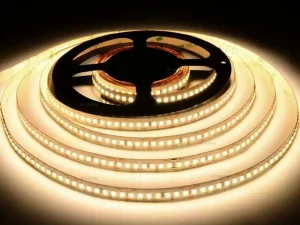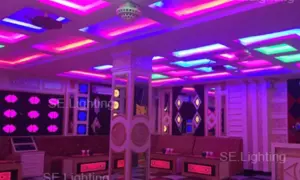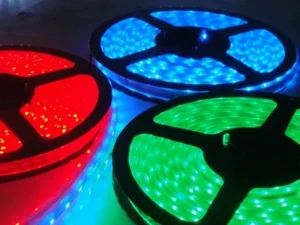If you plan to install LED strip lights in your home, you might wonder how long they last. LED strip lights have become increasingly popular for both decorative and functional lighting. And luckily, their longevity is one of their best-selling points. How long do LED strip lights last? Explore their typical lifespan, key factors influencing durability, and practical tips to extend their life.
Average Life Span: How Long Do LED Strip Lights Last
How long do LED light strips last? Most high-quality LED strips last between 30,000 and 50,000 hours when used properly. If you run your LED strips for 8 hours each day, they could keep working for 10 to 17 years. However, several factors can negatively affect the lifespan of your LED strip lights.

Factors Affecting The Lifespan of LED Strip Lights
-
Quality of the Components
The primary factor determining “how long do LED strip lights last” is the quality of the LED chips and other inbuilt components. High-quality strip manufacturers use better materials and construction methods to create longer-lasting products.
High-quality LED strips may cost more upfront than their cheaper counterparts. Still, their extended lifespan makes them more economical in the long run. Instead of repeatedly replacing lower-quality strips, investing in quality ones saves money over time.
-
Temperature Management
Many ask, “Do LED strip lights get hot?”
LEDs generate less heat than traditional bulbs, but they still produce some warmth. While this warmth is safe and normal, excessive heat can damage the strips and shorten their lifespan.
Good airflow around your LED strips is essential. Install them in well-ventilated areas and avoid enclosed spaces where heat builds up. If you’re not confident about installing them, consider hiring a professional.
-
Power Supply and Electrical Factors
The right power supply is crucial for longevity. Many people ask, “Do LED light strips burn out?” The answer is yes.
Using the wrong voltage or an unstable power supply can cause premature burnout. Like all electrical components, LED strips can fail when exposed to power surges or incorrect voltage. The perfect power supply for LED strips should have a voltage output of 12V or 24V and at least 20% more wattage capacity than the strips need.
To protect your investment, use a high-quality power supply that matches the specifications of your strips. Consider adding a voltage regulator for extra protection. Sudden power changes should also be avoided to prevent stress on the components and prolong their life.
Maximizing The Lifespan of LED Strip Lights

-
Regular Cleaning:
Keep your LED strips free from dust and debris because they can trap heat and reduce efficiency. A gentle wipe with a dry cloth every few months should suffice.
-
Proper Installation:
Ensure the strips are well attached to the surface and avoid sharp bends that could damage the internal connections. Use mounting clips or channels when necessary for better support and heat reduction.
-
Voltage Regulation:
Install a quality voltage regulator to protect your LED strips from power surges and inconsistent voltage.
-
Use Dimmers:
You can control the brightness of your strips with dimmers to reduce power consumption and heat generation. This is necessary for times when full brightness is unnecessary.
Signs of LED Strip Light Degradation
As LED strips age, you might notice several warning signs that indicate degradation:
-
Decreased brightness:
You might find yourself constantly adjusting the brightness settings upward, trying to combat the shadows appearing in previously well-lit areas. This declining brightness is often one of the first signs that your strips are aging.
-
Color shifts in RGB strips:
The vivid colors that once made your RGB strips stunning may start to fade. White lights might develop an unwanted yellowish or bluish tinge, and you’ll notice that mixing colors doesn’t produce the same crisp, precise results as before. These color shifts can be particularly noticeable when you try to create specific moods or match existing lighting.

-
Individual LEDs failing:
Watch for LEDs that start misbehaving. Some might flicker like a candle in the wind, while others work only when they feel like it. In addition, you might notice an odd pattern where some LEDs stay dim while others remain bright.
-
Uneven Lighting Performance:
There will be noticeable variations in light intensity across the strip. If your strips start flickering when slightly moved or touched, it’s a sign that internal connections are wearing out.
When to Replace LED Strip Lights
While LED strips can last many years, you should consider getting new ones if:
- More than 20% of the LEDs have failed
- The color accuracy has significantly degraded
- The strips show signs of physical damage
- The power consumption is higher than normal
Energy Efficiency and Operating Costs
One common question among potential buyers is: Do LED strip lights use a lot of electricity? The good news is that LED strip lights are incredibly energy-efficient. Compared to traditional lighting options, they consume less power while providing the same illumination level or better.
When considering “how much electricity do LED light strips use,” a typical 5-meter strip running at full brightness consumes between 20 and 30 watts. This efficient power usage means you don’t have to worry about the subsequent question of “How much do LED strip lights cost to run.” These devices add only a few dollars to your monthly electrical bill so you won’t go bankrupt.
How Long Do LED Strips Last: Conclusion
LED strip lights offer an impressive combination of longevity and energy efficiency that’s difficult to match. These versatile lighting solutions can illuminate your space for over a decade when properly maintained. Their lifespan varies depending on several factors—from the quality of components to how you use them—but most quality LED strips can easily last 30,000 to 50,000 hours of operation.
Understanding the importance of following proper installation and maintenance practices can help you maximize your investment. These are your best allies.
Remember that LED light strips have a higher initial cost than other common lighting options. You might pay more upfront, but LED strips prove their worth over time. Their minimal power consumption and remarkable durability make them one of the most cost-effective lighting choices today.
